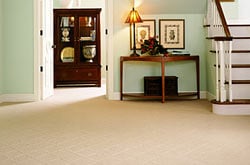Making Carpet Installation and Maintenance Green
See if We Have Top-Rated
Green Professionals in Your Area

While carpet is one of the most popular flooring materials in American homes, it isn't the greenest flooring material around. Residential carpeting can off-gas a host of potentially harmful volatile organic compounds (VOCs) into your indoor air, and the 2.5 million tons of non-biodegradable carpet and carpet backing that is dumped into landfills every year doesn't help its reputation in green circles, either. Nevertheless, there are measures you can take to help counter these less than desirable aspects of carpeting in your home. Whether you're planning on installing new carpet, or just want to make sure the carpet you already have meets the highest standards of "green," this is the project guide you've been searching for.
Going Green with David Johnston
When it comes to greening your carpet, HomeAdvisor understands that it can be tough for homeowners to wade through all the purported "green" remodeling information out there. That's why we've teamed up with green remodeling expert David Johnston to provide you with the best, most accurate, green remodeling advice in the business. Johnston is the founder of the green consulting firm What's Working, Inc., the author of multiple books on green remodeling (including the Nautilus Award winner Green Remodeling: Changing the World One Room at a Time), and he's got a wealth of information for homeowners looking to go green in the carpeting department. Here's a list of everything you need to know about carpet from a green perspective, drawn from the experience, wisdom, and writings of Johnston himself.
What You Need to Know About Carpet and Your Health
Despite being installed in 70 percent of American homes, Johnston is quick to point out that the skinny on carpeting from a green standpoint isn't so hot. Carpet, carpet backing, and carpet underlayment contain hundreds of chemical compounds, many of which can off-gas dangerous VOCs into your home for years after your carpet is installed. In addition, even more VOCs are released into your indoor air by carpet related binders, fiber bonding materials, adhesives, fire retardants, stain resistant treatments, anti-static treatments, dyes, and fungicides. With links to health problems as varied as cancer, respiratory problems, and neurological disorders, just to name a few, you can see why the potentially negative health effects of carpet might raise concerns for many in the green remodeling industry.
David Johnston's Suggestions for Healthier, Greener Carpeting
That being said, there are things that an average homeowner can do to help turn what appears to be an un-green flooring material into something a little more environmentally friendly. Here's a list of suggestions from Johnston to help you ensure your carpet is as healthy, and as green, as possible:
Going Green with Carpeting
Financially, going green with your carpeting probably isn't going to affect your bottom line very much, since greening your carpet is as much about adopting smart installation and maintenance techniques as anything else. That doesn't mean that going green is a waste of your time, however. Johnston stresses that the true value of going green lays in areas other than your budget— and carpeting is no exception. Making sure your carpet meets green expectations means that you're investing in a healthier home for you and your family and a more environmentally friendly world for generations to come — both things that are impossible to put a price tag on.
If you do think green is a smart choice for your carpet installation, talk with your contractor about adopting a green remodeling philosophy, find a contractor who specializes in green building and remodeling, or seek out the services of a green consulting firm so that you can be sure your carpet installation or maintenance task is as green as possible.
More Tips & Advice For Your Home
- Related Articles
- Recent Articles

